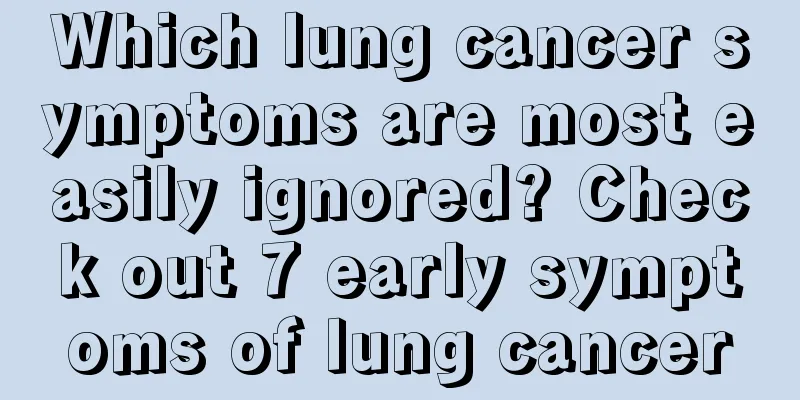Which lung cancer symptoms are most easily ignored? Check out 7 early symptoms of lung cancer

|
The early symptoms of lung cancer are not very obvious, so the chances of many lung cancer patients being discovered early are very small. By the time many patients discover abnormalities, it is too late and they have already reached the late stage of lung cancer, thus losing the best treatment period. The following summarizes the early symptoms of lung cancer to help patients detect the disease early and receive better treatment. The most easily ignored early symptoms of lung cancer: joint symptoms When it comes to the early symptoms of lung cancer, many people will think of coughing, hoarseness, etc., but in fact, joint symptoms are also one of the main early signs of lung cancer: changes in body joints are one of the early symptoms of lung cancer. However, in general, when the lesions of lung cancer are very small, the occurrence of arthritis is not easy to be discovered, and it only manifests as migratory arthritis symptoms. The body joints experience burning pain, leading to obstacles in movement, and periosteal hyperplasia may also occur. Here is a reminder that if early arthritis occurs and the cause is unknown, you can go for a lung examination to rule out lung cancer. Other early symptoms of lung cancer 1. Cough: Because the lesions of lung cancer are on the bronchial lung tissue, the respiratory tract is often irritated, leading to the occurrence of irritating cough. 2. Coughing up blood: If such symptoms occur, you should seek medical attention in time. The characteristics of lung cancer hemoptysis are that middle-aged and elderly people suddenly cough up blood, or sputum with blood, which is often misdiagnosed as pneumonia, recurring, and spitting bloody sputum. 3. Pericardium invasion: When the pericardium of a lung cancer patient is invaded, it often causes pericardial effusion, shortness of breath, arrhythmia and other phenomena. 4. Phrenic nerve paralysis: It is also one of the early symptoms of lung cancer. When the phrenic nerve is paralyzed, patients often experience shortness of breath and chest tightness. 5. Hoarseness: This is the most common symptom of early lung cancer. It may occur after pharyngitis, colds, thyroid surgery, acute bronchitis, and pharyngeal surgery. It may also occur after improper voice production, excessive talking, or even heavy smoking and drinking. 6. Chest pain: In the early stages of lung cancer, chest pain is mainly dull pain or dull pain, and this symptom is most likely to be ignored. Many patients even choose to endure it because the pain does not occur continuously. 7. Fever: Generally around 38°C, which can be easily reduced by anti-inflammatory treatment. When central lung cancer grows in the bronchus and develops to the point of semi-obstruction or complete obstruction of the lumen, obstructive pneumonia may occur. Traditional Chinese medicine ginsenoside Rh2 assists early lung cancer surgery to increase cure rate Common treatments for lung cancer include surgery, radiotherapy, chemotherapy, targeted therapy, and traditional Chinese medicine. Among them, surgery is the most effective treatment for early lung cancer, but it causes great trauma to patients and is not suitable for late-stage lung cancer. It is often a temporary solution and not a permanent cure, and patients with weak constitutions often cannot bear it. Therefore, it is very important to detect lung cancer and perform surgery in its early stages. Combining Chinese and Western medicine treatment is currently a popular research topic in lung cancer treatment. According to clinical data feedback, the combination of traditional Chinese medicine ginsenoside Rh2 before and after surgery can inhibit the proliferation of cancer cells, induce cancer cell apoptosis, shrink the tumor before surgery, and greatly increase the success rate of surgery through immune regulation after surgery, thereby improving the cure rate of lung cancer. Ginsenoside Rh2 monomers with a content higher than 16% have good targeting and absorption utilization rate. When used in auxiliary surgical treatment, they are mainly manifested in killing cancer cells, reducing surgical difficulty, improving immunity, and accelerating postoperative recovery. Experimental studies have shown that ginsenoside Rh2 can promote the secretion of cytotoxic effector molecules by alveolar macrophages in patients with non-small cell lung cancer, induce the expression of MHC-Ⅱ class antigens and Fc receptors, and regulate the production of active substances such as TNF-α, NO and IL-1. In turn, TNF-α can act on macrophages to increase the secretion of NO. NO is a cytotoxic effector molecule, thereby killing tumor cells. In summary, ginsenoside Rh2 can regulate and enhance the body's immune function through various pathways and has a protective effect on the immune system. Lung cancer is very scary, but if it can be detected and treated early, there is still room for recovery. The above is a summary of the early symptoms of lung cancer. I hope that through this information, I can provide more help to everyone. If lung cancer can be detected in the early stage and treated in time, it will be very beneficial for the long-term survival of lung cancer patients. |
>>: What should I do if I have advanced lung cancer? What are the symptoms of advanced lung cancer?
Recommend
Is elevated thyroid stimulating hormone hypothyroidism or hyperthyroidism?
Thyroid stimulating hormone is very important to ...
Can nasopharyngeal carcinoma be cured after radiotherapy and chemotherapy? What are the dietary treatments?
As with any cancer, in the late stages, treatment...
Are electric mosquito coils harmful to humans?
The arrival of summer not only brings heat, but a...
How to cool down a room quickly?
Summer is a relatively hot season, and it is easy...
Bartholin's gland cyst
When it comes to Bartholin's gland cyst, perh...
What are the diagnostic criteria for fatty liver
With the continuous improvement of living conditi...
Can severe periodontitis be cured?
Teeth are a very important part of our body. If h...
What are the symptoms of lung cancer in daily life?
What are the symptoms of lung cancer in daily lif...
What are the main daily medications for teratoma patients
Teratoma is a common disease in women. It is a be...
Can I eat lotus root when I have a cough?
However, if you experience coughing in the human ...
Treatment of gallbladder cancer metastasis
Gallbladder cancer grows rapidly after onset and ...
What to do if you are allergic to the legs of glasses
More and more people are suffering from myopia, s...
How to take bear bile powder? Do you know its pharmacological effects?
Bear bile powder has a very strong pharmacologica...
How much does it cost to check for ovarian tumors
Ovarian tumor refers to a tumor that occurs on th...
Is it good to drink honey water every day
Honey water is made from honey. Honey water not o...









